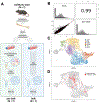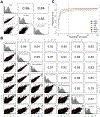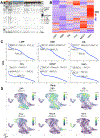Single-Cell Transcriptomics of Bone Marrow Stromal Cells in Diversity Outbred Mice: A Model for Population-Level scRNA-Seq Studies
- PMID: 37436066
- PMCID: PMC10528806
- DOI: 10.1002/jbmr.4882
Single-Cell Transcriptomics of Bone Marrow Stromal Cells in Diversity Outbred Mice: A Model for Population-Level scRNA-Seq Studies
Abstract
Genome-wide association studies (GWASs) have advanced our understanding of the genetics of osteoporosis; however, the challenge has been converting associations to causal genes. Studies have utilized transcriptomics data to link disease-associated variants to genes, but few population transcriptomics data sets have been generated on bone at the single-cell level. To address this challenge, we profiled the transcriptomes of bone marrow-derived stromal cells (BMSCs) cultured under osteogenic conditions from five diversity outbred (DO) mice using single-cell RNA-seq (scRNA-seq). The goal of the study was to determine if BMSCs could serve as a model to generate cell type-specific transcriptomic profiles of mesenchymal lineage cells from large populations of mice to inform genetic studies. By enriching for mesenchymal lineage cells in vitro, coupled with pooling of multiple samples and downstream genotype deconvolution, we demonstrate the scalability of this model for population-level studies. We demonstrate that dissociation of BMSCs from a heavily mineralized matrix had little effect on viability or their transcriptomic signatures. Furthermore, we show that BMSCs cultured under osteogenic conditions are diverse and consist of cells with characteristics of mesenchymal progenitors, marrow adipogenic lineage precursors (MALPs), osteoblasts, osteocyte-like cells, and immune cells. Importantly, all cells were similar from a transcriptomic perspective to cells isolated in vivo. We employed scRNA-seq analytical tools to confirm the biological identity of profiled cell types. SCENIC was used to reconstruct gene regulatory networks (GRNs), and we observed that cell types show GRNs expected of osteogenic and pre-adipogenic lineage cells. Further, CELLECT analysis showed that osteoblasts, osteocyte-like cells, and MALPs captured a significant component of bone mineral density (BMD) heritability. Together, these data suggest that BMSCs cultured under osteogenic conditions coupled with scRNA-seq can be used as a scalable and biologically informative model to generate cell type-specific transcriptomic profiles of mesenchymal lineage cells in large populations. © 2023 The Authors. Journal of Bone and Mineral Research published by Wiley Periodicals LLC on behalf of American Society for Bone and Mineral Research (ASBMR).
Keywords: OSTEOBLASTS; OSTEOCYTES; OSTEOPOROSIS; STROMAL/STEM CELLS; SYSTEMS BIOLOGY - OTHER.
© 2023 The Authors. Journal of Bone and Mineral Research published by Wiley Periodicals LLC on behalf of American Society for Bone and Mineral Research (ASBMR).
Conflict of interest statement
Disclosure Statement / Conflict of Interest
The authors declare that they have no conflicts of interest with the contents of this article.
Figures






References
-
- Lin JT, Lane JM. Osteoporosis: a review. Clin Orthop Relat Res. 2004. Aug;(425):126–34. - PubMed
-
- Peacock M, Turner CH, Econs MJ, Foroud T. Genetics of osteoporosis. Endocr Rev. 2002. Jun;23(3):303–26. - PubMed
-
- Tam V, Patel N, Turcotte M, Bossé Y, Paré G, Meyre D. Benefits and limitations of genome-wide association studies. Nat Rev Genet. 2019. Aug;20(8):467–84. - PubMed
Publication types
MeSH terms
Grants and funding
LinkOut - more resources
Full Text Sources

